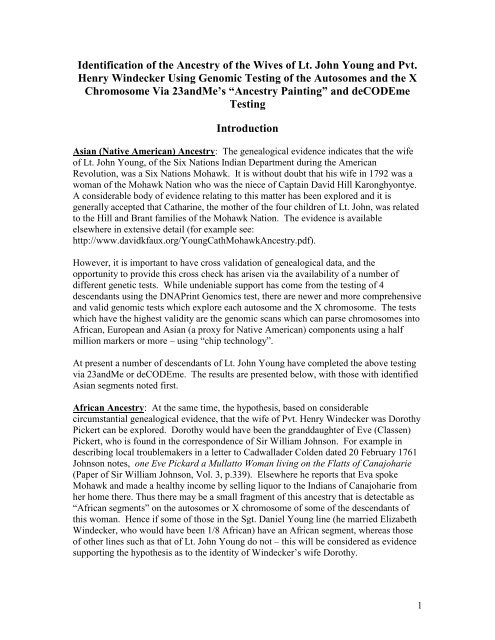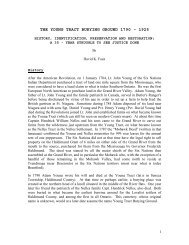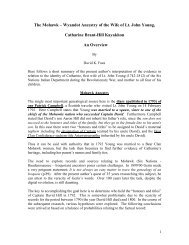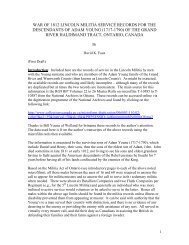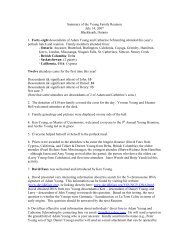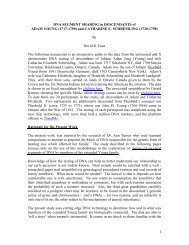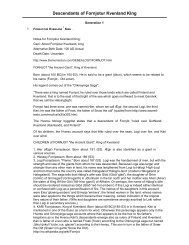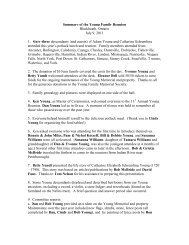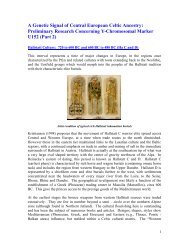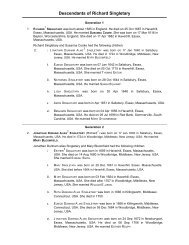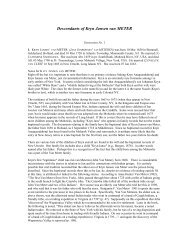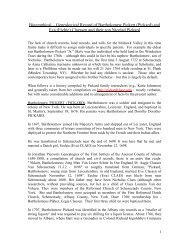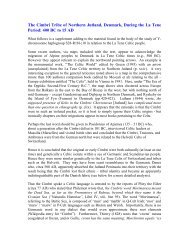Identification of the Ancestry of the Wives of Lt ... - Davidkfaux.org
Identification of the Ancestry of the Wives of Lt ... - Davidkfaux.org
Identification of the Ancestry of the Wives of Lt ... - Davidkfaux.org
You also want an ePaper? Increase the reach of your titles
YUMPU automatically turns print PDFs into web optimized ePapers that Google loves.
<strong>Identification</strong> <strong>of</strong> <strong>the</strong> <strong>Ancestry</strong> <strong>of</strong> <strong>the</strong> <strong>Wives</strong> <strong>of</strong> <strong>Lt</strong>. John Young and Pvt.<br />
Henry Windecker Using Genomic Testing <strong>of</strong> <strong>the</strong> Autosomes and <strong>the</strong> X<br />
Chromosome Via 23andMe’s “<strong>Ancestry</strong> Painting” and deCODEme<br />
Testing<br />
Introduction<br />
Asian (Native American) <strong>Ancestry</strong>: The genealogical evidence indicates that <strong>the</strong> wife<br />
<strong>of</strong> <strong>Lt</strong>. John Young, <strong>of</strong> <strong>the</strong> Six Nations Indian Department during <strong>the</strong> American<br />
Revolution, was a Six Nations Mohawk. It is without doubt that his wife in 1792 was a<br />
woman <strong>of</strong> <strong>the</strong> Mohawk Nation who was <strong>the</strong> niece <strong>of</strong> Captain David Hill Karonghyontye.<br />
A considerable body <strong>of</strong> evidence relating to this matter has been explored and it is<br />
generally accepted that Catharine, <strong>the</strong> mo<strong>the</strong>r <strong>of</strong> <strong>the</strong> four children <strong>of</strong> <strong>Lt</strong>. John, was related<br />
to <strong>the</strong> Hill and Brant families <strong>of</strong> <strong>the</strong> Mohawk Nation. The evidence is available<br />
elsewhere in extensive detail (for example see:<br />
http://www.davidkfaux.<strong>org</strong>/YoungCathMohawk<strong>Ancestry</strong>.pdf).<br />
However, it is important to have cross validation <strong>of</strong> genealogical data, and <strong>the</strong><br />
opportunity to provide this cross check has arisen via <strong>the</strong> availability <strong>of</strong> a number <strong>of</strong><br />
different genetic tests. While undeniable support has come from <strong>the</strong> testing <strong>of</strong> 4<br />
descendants using <strong>the</strong> DNAPrint Genomics test, <strong>the</strong>re are newer and more comprehensive<br />
and valid genomic tests which explore each autosome and <strong>the</strong> X chromosome. The tests<br />
which have <strong>the</strong> highest validity are <strong>the</strong> genomic scans which can parse chromosomes into<br />
African, European and Asian (a proxy for Native American) components using a half<br />
million markers or more – using “chip technology”.<br />
At present a number <strong>of</strong> descendants <strong>of</strong> <strong>Lt</strong>. John Young have completed <strong>the</strong> above testing<br />
via 23andMe or deCODEme. The results are presented below, with those with identified<br />
Asian segments noted first.<br />
African <strong>Ancestry</strong>: At <strong>the</strong> same time, <strong>the</strong> hypo<strong>the</strong>sis, based on considerable<br />
circumstantial genealogical evidence, that <strong>the</strong> wife <strong>of</strong> Pvt. Henry Windecker was Dorothy<br />
Pickert can be explored. Dorothy would have been <strong>the</strong> granddaughter <strong>of</strong> Eve (Classen)<br />
Pickert, who is found in <strong>the</strong> correspondence <strong>of</strong> Sir William Johnson. For example in<br />
describing local troublemakers in a letter to Cadwallader Colden dated 20 February 1761<br />
Johnson notes, one Eve Pickard a Mullatto Woman living on <strong>the</strong> Flatts <strong>of</strong> Canajoharie<br />
(Paper <strong>of</strong> Sir William Johnson, Vol. 3, p.339). Elsewhere he reports that Eva spoke<br />
Mohawk and made a healthy income by selling liquor to <strong>the</strong> Indians <strong>of</strong> Canajoharie from<br />
her home <strong>the</strong>re. Thus <strong>the</strong>re may be a small fragment <strong>of</strong> this ancestry that is detectable as<br />
“African segments” on <strong>the</strong> autosomes or X chromosome <strong>of</strong> some <strong>of</strong> <strong>the</strong> descendants <strong>of</strong><br />
this woman. Hence if some <strong>of</strong> those in <strong>the</strong> Sgt. Daniel Young line (he married Elizabeth<br />
Windecker, who would have been 1/8 African) have an African segment, whereas those<br />
<strong>of</strong> o<strong>the</strong>r lines such as that <strong>of</strong> <strong>Lt</strong>. John Young do not – this will be considered as evidence<br />
supporting <strong>the</strong> hypo<strong>the</strong>sis as to <strong>the</strong> identity <strong>of</strong> Windecker’s wife Dorothy.<br />
1
Genetic Testing<br />
Until recently genetic genealogists were reliant on tests such as DNAPrint (using 176<br />
Ancestral Informative SNP markers). Here <strong>the</strong> four descendants <strong>of</strong> <strong>Lt</strong>. John Young and<br />
Catharine showed varying amounts <strong>of</strong> Native American, East Asian or both. However<br />
this test has largely been discredited since, for example, Pakistanis typically have test<br />
results <strong>of</strong> about 30%, and Greeks 10% Native American – which makes no genetic sense.<br />
Thus all <strong>of</strong> <strong>the</strong> testing <strong>of</strong> <strong>the</strong> Young family done with this instrument over <strong>the</strong> years may<br />
need to be omitted for any consideration.<br />
Both 23andMe and deCODEme use over half a million SNP markers and this represents a<br />
major step forward in personal genomics testing for ancestry. Hence <strong>the</strong> results from <strong>the</strong><br />
analyses <strong>of</strong> both companies will be taken as “<strong>the</strong> best option” available to date and<br />
serious consideration must be given to <strong>the</strong> outputs here which identify percentage <strong>of</strong><br />
European, Asian (Native Americans typically score 75% plus or minus 10% here), and<br />
African. The reference groups are somewhat restricted and include <strong>the</strong> HapMap Utah<br />
sample for Europeans, <strong>the</strong> Yoruba Nigerians for Africans, and <strong>the</strong> Han Chinese for<br />
Asians. Thus if a block or segment <strong>of</strong> a chromosome clusters more with <strong>the</strong> Han than<br />
o<strong>the</strong>r groups it will be labeled “Asian” and its boundaries defined.<br />
In <strong>the</strong> analysis to follow we will explore <strong>the</strong> autosomal data (22 pairs <strong>of</strong> autosomes) first,<br />
<strong>the</strong>n <strong>the</strong> X chromosome. The autosomes experience meiosis (recombination) with each<br />
generation (although some chromosomes will experience none and two individuals in <strong>the</strong><br />
same family will ei<strong>the</strong>r inherit <strong>the</strong> whole chromosome or none. Typically <strong>the</strong>re are fewer<br />
recombination events in males (females to males ratio <strong>of</strong> 1.6 to 1), and so <strong>the</strong> ideal<br />
candidate would be a male who is only a few generations removed from say <strong>Lt</strong>. John<br />
Young. The candidate which best fulfills this criteria here is Larry Young who is only 5<br />
recombinations meaning he is 5 generations removed from <strong>Lt</strong>. John Young who is his<br />
great great great grandfa<strong>the</strong>r.<br />
The X chromosome has a different inheritance pattern such that only certain members <strong>of</strong><br />
<strong>the</strong> family will have <strong>the</strong> potential <strong>of</strong> a genetic contribution from one or more <strong>of</strong> <strong>the</strong><br />
Young family branches. For example if your fa<strong>the</strong>r’s fa<strong>the</strong>r was <strong>the</strong> Young descendant,<br />
whe<strong>the</strong>r male or female you did not inherit <strong>the</strong> anything on <strong>the</strong> X from <strong>the</strong> Young family<br />
– it is largely a maternal lineage marker set. Dale Williamson is only three meioses<br />
(recombinations) from <strong>the</strong> wife <strong>of</strong> <strong>Lt</strong>. John Young and his nephew David is four meioses<br />
removed. The range here is zero to 100% with <strong>the</strong> former more likely than <strong>the</strong> latter.<br />
Also in <strong>the</strong> running (<strong>the</strong> exact meiotic connection is not yet clear) are Robert Nelson and<br />
Gerry Kenney. At <strong>the</strong> present point in time 23andMe does not “paint” <strong>the</strong> X so we do not<br />
know directly which segments are Asian etc. For those participants who have<br />
deCODEme data, <strong>the</strong> visual patterns can be an indicator <strong>of</strong> what will likely be found<br />
when 23andMe addresses this matter.<br />
2
Autosomal Data<br />
Tom Nelson – Mohawk or Ukrainian Asian Segment?<br />
The Asian segment has two possible sources, <strong>the</strong> Mohawk wife <strong>of</strong> <strong>Lt</strong>. John Young, or<br />
Tom’s maternal Ukrainian line. To explore <strong>the</strong>se two options, it would be helpful to<br />
determine whe<strong>the</strong>r that particular segment came from <strong>the</strong> paternal or maternal line. If<br />
Tom matches one <strong>of</strong> his paternal relatives <strong>the</strong>re, and that individual does not have <strong>the</strong><br />
segment labeled Asian, <strong>the</strong>n <strong>the</strong> answer is clear. This hypo<strong>the</strong>sis was tested via a<br />
comparison with Tom’s paternal uncle Robert Nelson (also a descendant <strong>of</strong> <strong>Lt</strong>. John<br />
Young).<br />
3
Comparison Between Tom Nelson and his Paternal Uncle Robert Nelson:<br />
Focus on Chromosome 12<br />
Young Family Asian Segments on <strong>the</strong> Autosomes Using <strong>the</strong> “FetchPaint” Coding<br />
1) Thomas Nelson – 23andMe Segments from <strong>Ancestry</strong> Painting <strong>of</strong> 23andMe<br />
{"intervals": "{\"20\": [[11244, 62382907, \"CC\"]], \"21\": [[9993822, 46909417, \"CC\"]], \"22\":<br />
[[14884399, 49524956, \"CC\"]], \"1\": [[742429, 247177330, \"CC\"]], \"3\": [[38411, 199298372,<br />
\"CC\"]], \"2\": [[19443, 242692820, \"CC\"]], \"5\": [[91139, 180623543, \"CC\"]], \"4\": [[63508,<br />
191164126, \"CC\"]], \"7\": [[140736, 158812247, \"CC\"]], \"6\": [[110391, 170750927, \"CC\"]],<br />
\"9\": [[36587, 140147760, \"CC\"]], \"8\": [[154984, 146245512, \"CC\"]], \"11\": [[188510,<br />
134445626, \"CC\"]], \"10\": [[103934, 135284293, \"CC\"]], \"13\": [[18132747, 114121252,<br />
4
\"CC\"]], \"12\": [[64079, 103144768, \"CC\"], [103180256, 111803854, \"AC\"], [111806963,<br />
132288869, \"CC\"]], \"15\": [[18421386, 100215583, \"CC\"]], \"14\": [[19283777, 106358708,<br />
\"CC\"]], \"17\": [[51088, 78634366, \"CC\"]], \"16\": [[37354, 5988683, \"CC\"], [5990074, 6005359,<br />
\"AC\"], [6005483, 6022554, \"CC\"], [6022759, 6248165, \"AC\"], [6250234, 88668978, \"CC\"]],<br />
\"19\": [[217034, 63779291, \"CC\"]], \"18\": [[59836, 76116152, \"CC\"]]}", "p1":<br />
"6287386a0885c7ab", "popstruct": {"results": [["Europe", ">99%"], ["Asia", "<1%"], ["Africa",<br />
"0%"], ["unassigned", "0%"]], "desc": ""}, "function_call": "paint"}<br />
Asian segments<br />
DeCODEme Analysis <strong>of</strong> Autosomes and X Chromosome for Tom Nelson<br />
Note that <strong>the</strong>re is no correspondence between <strong>the</strong> displays (paintings) <strong>of</strong> 23andme and<br />
DeCODEme for Tom. The Asian segment on Chromosome 12 from 23andMe does not<br />
show in <strong>the</strong> above DeCODEme analysis; and 23andMe does not detect <strong>the</strong> large Asian<br />
blocks on Chromosome 1, and <strong>the</strong> African block on Chromosome 8 shown in <strong>the</strong> display<br />
via DeCODEme. This inconsistency makes it very difficult to determine which <strong>of</strong> <strong>the</strong><br />
two data sources is correct – if ei<strong>the</strong>r.<br />
5
Above is a closer look at <strong>the</strong> large (about 15 Mb) African block <strong>of</strong> Tom Nelson on<br />
Chromsome 8 via <strong>the</strong> DeCODEme browser. This constitutes strong evidence <strong>of</strong> some<br />
African ancestry. The present author has not seen any blocks <strong>of</strong> this nature in those<br />
without documented or suspected African ancestry.<br />
2) Robert Nelson: 23andMe <strong>Ancestry</strong> Painting (Autosomes Only)<br />
{"intervals": "{\"20\": [[11244, 62382907, \"CC\"]], \"21\": [[9993822, 46909417, \"CC\"]], \"22\":<br />
[[14884399, 49524956, \"CC\"]], \"1\": [[742429, 245628855, \"CC\"], [245633498, 247177330,<br />
\"CY\"]], \"3\": [[38411, 199298372, \"CC\"]], \"2\": [[19443, 242692820, \"CC\"]], \"5\": [[91139,<br />
180623543, \"CC\"]], \"4\": [[63508, 191164126, \"CC\"]], \"7\": [[140736, 158812247, \"CC\"]],<br />
\"6\": [[110391, 170750927, \"CC\"]], \"9\": [[36587, 140147760, \"CC\"]], \"8\": [[154984,<br />
146245512, \"CC\"]], \"11\": [[188510, 134445626, \"CC\"]], \"10\": [[103934, 135284293, \"CC\"]],<br />
\"13\": [[18132747, 114121252, \"CC\"]], \"12\": [[64079, 132288869, \"CC\"]], \"15\": [[18421386,<br />
100215583, \"CC\"]], \"14\": [[19283777, 106358708, \"CC\"]], \"17\": [[51088, 78634366, \"CC\"]],<br />
\"16\": [[37354, 88668978, \"CC\"]], \"19\": [[217034, 63779291, \"CC\"]], \"18\": [[59836,<br />
76116152, \"CC\"]]}", "p1": "02cc9569c55fc7f1", "popstruct": {"results": [["Europe", ">99%"],<br />
["Asia", "0%"], ["Africa", "<1%"], ["unassigned", "0%"]], "desc": ""}, "function_call": "paint"}<br />
African segment<br />
6
Analysis: Tom and his Uncle Robert share <strong>the</strong> segment labeled Asian in Tom’s pr<strong>of</strong>ile<br />
above. This segment is found within <strong>the</strong> region shared between uncle and nephew from<br />
positions 8,000,000 to 123,000,000, all <strong>of</strong> which is categorized as European in Robert<br />
Nelson. Hence <strong>the</strong>re is no doubt that <strong>the</strong> Asian segment on Chromosome 12 came<br />
from Tom’s mo<strong>the</strong>r’s Ukrainian ancestry since Robert Nelson does not have any<br />
Asian segment anywhere on Chromosome 12.<br />
Both Tom and his uncle Robert have African segments on Chromosomes 8 and 1<br />
respectively when taking <strong>the</strong> DeCODEme and 23andMe data into consideration. The<br />
DeCODEme output was generated using <strong>the</strong> latter’s algorithm on Tom’s data uploaded<br />
from 23andMe. Both are descendants <strong>of</strong> Pvt. Henry Windecker in ei<strong>the</strong>r one or two<br />
branches.<br />
3) Larry Young, Raleigh Young, Mike Young, Richard Lidzbarski, Beth Einig,<br />
Paul Fawcett, Dale Williamson, David Faux, Gerry Kenney: 23andMe <strong>Ancestry</strong><br />
Painting (Autosomes Only)<br />
{"intervals": "{\"20\": [[11244, 62382907, \"CC\"]], \"21\": [[9993822, 46909417, \"CC\"]], \"22\":<br />
[[14884399, 49524956, \"CC\"]], \"1\": [[742429, 247177330, \"CC\"]], \"3\": [[38411, 199298372,<br />
\"CC\"]], \"2\": [[19443, 242692820, \"CC\"]], \"5\": [[91139, 180623543, \"CC\"]], \"4\": [[63508,<br />
191164126, \"CC\"]], \"7\": [[140736, 158812247, \"CC\"]], \"6\": [[110391, 170750927, \"CC\"]],<br />
\"9\": [[36587, 140147760, \"CC\"]], \"8\": [[154984, 146245512, \"CC\"]], \"11\": [[188510,<br />
134445626, \"CC\"]], \"10\": [[103934, 135284293, \"CC\"]], \"13\": [[18132747, 114121252,<br />
\"CC\"]], \"12\": [[64079, 132288869, \"CC\"]], \"15\": [[18421386, 100215583, \"CC\"]], \"14\":<br />
[[19283777, 106358708, \"CC\"]], \"17\": [[51088, 78634366, \"CC\"]], \"16\": [[37354, 88668978,<br />
\"CC\"]], \"19\": [[217034, 63779291, \"CC\"]], \"18\": [[59836, 76116152, \"CC\"]]}", "p1":<br />
"9a017a86e81067c4", "popstruct": {"results": [["Europe", "100%"], ["Asia", "0%"], ["Africa", "0%"],<br />
["unassigned", "0%"]], "desc": ""}, "function_call": "paint"}<br />
100% European<br />
7
Although somewhat difficult to see in <strong>the</strong> above display mode, this is <strong>the</strong> representation<br />
<strong>of</strong> <strong>the</strong> DeCODEme data for David Faux, with possible Asian and African ancestry shown<br />
here, especially on <strong>the</strong> X chromosome.<br />
The X Chromosome Data From DeCODEme<br />
Due to <strong>the</strong> different inheritance pattern <strong>of</strong> <strong>the</strong> X chromosome relative to <strong>the</strong> autosomes,<br />
only four <strong>of</strong> <strong>the</strong> individuals tested so far have <strong>the</strong> potential to have a segment from <strong>Lt</strong>.<br />
John Young’s wife Catharine appear on <strong>the</strong>ir X (<strong>the</strong> data from 23andMe for Robert<br />
Nelson was unavailable for upload to deCODEme).<br />
The predicted percentages are as follows, Dale Williamson 12.5% (range 0 to 100%),<br />
David Faux 6.25% (range 0 to 100% with <strong>the</strong> former considerably more likely than <strong>the</strong><br />
latter due to meiotic recombination). At <strong>the</strong> moment it is unclear what <strong>the</strong> predicted<br />
percentage is for Robert Nelson but one can see that <strong>the</strong>re is a sizeable Asian componsent<br />
to <strong>the</strong> X <strong>of</strong> his great nephew Gerry Kenney (<strong>the</strong> two share <strong>the</strong> first 25 Mb from <strong>the</strong> p end,<br />
ending about half way through <strong>the</strong> Asian segment seen <strong>of</strong> Gerry’s X below.<br />
8
Since deCODEme does not <strong>of</strong>fer any interpretation <strong>of</strong> <strong>the</strong> charts, one is left to sort out<br />
signal from noise and this is difficult without any clear standard for a “meaningful” block<br />
or segment.<br />
The screenshot below shows <strong>the</strong> Asian (gold coloured) segments for David Faux, Dale<br />
Williamson, and Gerry Kenney. Since males have only one chromosome any Asian<br />
block should reach at least 65% if it is Native American (NA = 75% + or – 10% <strong>of</strong><br />
Asian). There is noise that only an algorithm can screen out to see <strong>the</strong> “signal” or<br />
meaningful data. Uploads <strong>of</strong> 23andMe data to DeCODEme are used since 23andMe does<br />
not yet paint <strong>the</strong> X chromosome.<br />
9
The given percentages are 0% Asian for Dale Williamson, 5% for David Faux, and 11%<br />
Asian for Gerry Kenney (data for Robert Nelson is unavailable). At present <strong>the</strong><br />
interpretation <strong>of</strong> <strong>the</strong>se results is unclear, and it would be best to wait until 23andMe<br />
“paint” <strong>the</strong> X chromosome for fur<strong>the</strong>r analysis.<br />
As seen above <strong>the</strong> percentage <strong>of</strong> African is relatively high in David Faux (8%), with one<br />
giant block accounting for a large percentage <strong>of</strong> this figure. The positioning <strong>of</strong> <strong>the</strong> block<br />
near <strong>the</strong> centromere, however, makes it entirely possible that this finding is little more<br />
than noise, hence <strong>the</strong> importance <strong>of</strong> 23andMe data to support or refute <strong>the</strong> finding.<br />
Testing with BEAGLE (Dr. McDonald)<br />
Ano<strong>the</strong>r test with high validity indicators include <strong>the</strong> testing by Dr. McDonald who uses<br />
<strong>the</strong> programme BEAGLE to analyze <strong>the</strong> raw data downloaded from 23andMe. There is a<br />
1% margin <strong>of</strong> error in this test. The findings in relation to “Amerindian” are as follows:<br />
a) Larry Young: Predicted 1/32 (1/64 due to admixture) or 1.56% – Result = 2.4%;<br />
result for African = 0.00%<br />
b) Dale Williamson: Predicted 1/128 (1/256 due to admixture) or 0.004% – Result =<br />
1.5%; result for African = minus 0.7%<br />
10
c) David Faux: Predicted 1/256 (1/512 due to admixture) or 0.008% - Result =<br />
1.5%; result for African = minus.6%<br />
d) Tom Nelson: Predicted 1/128 (1/256 due to admixture) or 0.004% - Result =<br />
1.3%; result for African = plus 1.2%<br />
O<strong>the</strong>r Pertinent Evidence<br />
By examining <strong>the</strong> results <strong>of</strong> o<strong>the</strong>rs who have a well documented genealogical trail to a<br />
Native American ancestor, and who tested with 23andMe, it will help to put <strong>the</strong> above in<br />
perspective. What follows are examples which seem to be somewhat typical, and come<br />
from Lists (Rootsweb) and Forums (DNA-Forums) that deal with this subject matter.<br />
1) One individual (O’Dair) reported that, to his surprise, he was found to have 4%<br />
Asian via <strong>the</strong> <strong>Ancestry</strong> Painting feature. Realizing that he had a great great great<br />
grandmo<strong>the</strong>r on his fa<strong>the</strong>r’s side who was from Mexico (likely Mestizo) <strong>the</strong> result<br />
began to make sense. In calculating <strong>the</strong> expected Asian percentage via his<br />
ancestry, it turned out to be just under 4% - <strong>the</strong> genealogy and <strong>the</strong> genetics being<br />
in perfect harmony.<br />
2) One might argue that using <strong>the</strong> Han as a reference group or proxy for Native<br />
Americans is debatable. There is a large body <strong>of</strong> evidence that those from<br />
Canada, particularly <strong>the</strong> Na Dene, Athapaskan, Chipewayan and to a somewhat<br />
lesser extent Ojibway – Chippewa more closely resemble Siberians than <strong>the</strong><br />
Native Americans from South America. It could be argued that <strong>the</strong> Mohawk and<br />
o<strong>the</strong>rs <strong>of</strong> nor<strong>the</strong>rn and central North America will be less likely “found” via <strong>the</strong><br />
standard procedures <strong>of</strong> looking at clustering with <strong>the</strong> Han versus European. It is<br />
well established that some Native American sequences cluster better with<br />
Europeans than <strong>the</strong> Han so <strong>the</strong>se segments will end up being falsely classified as<br />
European. However in one reported example, a genetic genealogist has an<br />
ancestor, Tarhe, a Wyandot chief. The Wyandot and <strong>the</strong> Mohawk should be<br />
virtually identical in terms <strong>of</strong> genomic structure since both are <strong>of</strong> related<br />
Iroquoian stock, and in <strong>the</strong> 1600s <strong>the</strong> Mohawks absorbed (adopted) so many<br />
Wyandot (Huron) that this element may actually predominate among Mohawk<br />
descendants. Dr. Jensen is 1/256 Wyandot via Tarhe. He has one Asian block.<br />
His mo<strong>the</strong>r is 1/128 Wyandot as is her first cousin. Both show 1% Asian, and his<br />
mo<strong>the</strong>r has 6 segments and her cousin 4 segments which are labeled Asian.<br />
3) The above (number 2) may be taken as a highly unusual finding in relation to<br />
remote ancestors. O<strong>the</strong>rs <strong>of</strong> undeniable Native American ancestry have returned<br />
with zero “Asian”. It is difficult to explain <strong>the</strong> discrepancy. For example in <strong>the</strong><br />
Google chart “BGA & 23andMe Company” we see “JC” who notes that his<br />
paternal grandmo<strong>the</strong>r was ¼ Native American (i.e., a great great grandmo<strong>the</strong>r).<br />
His 23andMe results were European > 99%, Asian = 0.1%. His BEAGLE test<br />
scores for Amerind are 0.7% (in o<strong>the</strong>r words less than one percent). The expected<br />
genetic contribution <strong>of</strong> a great great grandparent (1/16) is 6.25%.<br />
11
4) Ano<strong>the</strong>r example is BX with genealogical evidence <strong>of</strong> Native American ancestry<br />
and a score <strong>of</strong> 2.0% Amerind with <strong>the</strong> BEAGLE testing, but zero percent Asian<br />
with 23andMe. Her fa<strong>the</strong>r’s BEAGLE result was 2.8%, but he too came out with<br />
zero percent Asian on 23andMe.<br />
5) An even more perplexing case is TW who is <strong>of</strong> Creole descent with mixed<br />
African, European and Blackfoot Indian. While <strong>the</strong> 23andMe testing provides a<br />
percentage <strong>of</strong> 13.12% Asian (somewhat typical for African Americans), his<br />
BEAGLE score for Amerind is minus 1%.<br />
It is very difficult to make sense <strong>of</strong> <strong>the</strong> above when <strong>the</strong> only consistency is inconsistency.<br />
It was <strong>the</strong> naieve expectation <strong>of</strong> <strong>the</strong> author that <strong>the</strong> genomic scan testing would settle<br />
things once and for all with a crystal clear reflection <strong>of</strong> reality. This has not proved to be<br />
<strong>the</strong> case at all. It would seem that <strong>the</strong> genetic data juxtaposed with <strong>the</strong> circumstantial<br />
genealogical records in relation to <strong>the</strong> wife <strong>of</strong> Henry Windecker paints a fairly clear<br />
picture. This stands in stark contrast to that for <strong>Lt</strong>. John Young’s wife with an “air tight”<br />
genealogy which at best is only tentatively supported by <strong>the</strong> genetic findings.<br />
An Assessment <strong>of</strong> <strong>the</strong> Genetic Record: In considering <strong>the</strong> above Native American<br />
(Asian) information, it is important to note that Larry Young is <strong>the</strong> great great great<br />
grandson <strong>of</strong> <strong>Lt</strong>. John Young and his wife. If <strong>the</strong> latter was Mohawk one would expect to<br />
see about 3.125% Asian (or somewhat more due to <strong>the</strong> lower recombination rate in those<br />
who descend via a male to male to male pattern). Since Larry shows zero percent Asian<br />
one must seriously question whe<strong>the</strong>r his great great great grandmo<strong>the</strong>r was Mohawk<br />
(even admixed). Of <strong>the</strong> 10 descendants (7 certainly from <strong>Lt</strong>. John Young and his<br />
supposed Mohawk wife Catharine), <strong>the</strong>re is not a single individual who has even one<br />
solitary “Asian” block. While this could be discounted as an anomaly relating to <strong>the</strong><br />
23andMe testing, <strong>the</strong> above example <strong>of</strong> <strong>the</strong> descendants <strong>of</strong> Tarhe (an excellent parallel<br />
example) provides data that clearly accords with statistically expected figures. The<br />
expected 0.781% contribution from an ancestor at <strong>the</strong> 5 th great grandparent level (a<br />
descendant has a predicted percentage value to match <strong>the</strong> 1/128 figure – one out <strong>of</strong> 128<br />
ancestors) can be used to test <strong>the</strong> result obtained by 23andMe testing.<br />
In <strong>the</strong> case <strong>of</strong> <strong>the</strong> Young family, those who are 1/32 (3.125%), 1/128 (.781%), and 1/256<br />
(0.391%) have been assessed for percentage European, Asian, and African. A grand total<br />
<strong>of</strong> zero descendants, even those who via genealogical data are 1/32 (or 1/64 to account<br />
for admixture), have anything o<strong>the</strong>r than zero Asian. Surely if <strong>the</strong>re was any Native<br />
American ancestry in <strong>the</strong> family one might expect to see a few scattered blocks which are<br />
orange in colour, and in one or more instances, with <strong>the</strong> size matching or even exceeding<br />
<strong>the</strong> expected percentage contribution <strong>of</strong> <strong>the</strong> purported Mohawk ancestor. Descendants <strong>of</strong><br />
two sons, Abraham and John Jr., have been tested.<br />
O<strong>the</strong>r testing via DNAPrint, and with Dr. McDonald’s Biogeographical <strong>Ancestry</strong> testing<br />
with <strong>the</strong> programme BEAGLE, have provided results that are inconclusive. Any “Native<br />
American” percentages are also found commonly in those <strong>of</strong> 100% European ancestry<br />
12
from Finland or Scandinavia. Hence any Native American or East Asian values are<br />
questionable since <strong>the</strong> scores fall within <strong>the</strong> expected range <strong>of</strong> Europeans – but are also<br />
consistent with Amerind expected results.<br />
As to <strong>the</strong> African findings, Robert Nelson is shown to have an African block via<br />
23andMe testing. While his nephew Tom Nelson does not have a segment categorized as<br />
African via 23andMe, it is crystal clear that with <strong>the</strong> upload to deCODEme, that <strong>the</strong>re is a<br />
significant autosomal African block that can be seen in all visuals. In looking at <strong>the</strong><br />
genealogical record, Eva (Classen) Pickert would be a 7 th great grandparent to Tom and<br />
6 th for his Uncle Robert. Thus <strong>the</strong> predicted percentage would be 0.195% and 0.391%<br />
respectively – or more depending on whe<strong>the</strong>r both are descendants <strong>of</strong> Elizabeth Young<br />
(1827-1897) AND Henry Young (1825-1901). Thus <strong>the</strong> observed results are consistent<br />
with <strong>the</strong> paper trail.<br />
In addition, in Dr. McDonald’s biogeographical analysis using <strong>the</strong> programme BEAGLE,<br />
Tom has plus 1.2% African while <strong>the</strong> typical value for Europeans is minus 1.5%! Clearly<br />
<strong>the</strong>re is an African element in <strong>the</strong> Nelson branch, but until fur<strong>the</strong>r testing is done it cannot<br />
be demonstrated that this is due to <strong>the</strong> Windecker connection – unless <strong>the</strong> high African<br />
values on <strong>the</strong> X chromosome via deCODEme testing <strong>of</strong> David Faux will be recapitulated<br />
in <strong>the</strong> 23andMe testing – when and if this company ever “paints” <strong>the</strong> X chromosome.<br />
For <strong>the</strong> moment <strong>the</strong> most parsimonious interpretation is that <strong>the</strong> African segments come<br />
not from <strong>the</strong> Windecker ancestry, but from <strong>the</strong> Nelsons.<br />
The Genealogical Record: It has been assumed by all researchers that <strong>the</strong> wife <strong>of</strong> <strong>Lt</strong>.<br />
John Young who is described in <strong>the</strong> 1793 Campbell Diary is <strong>the</strong> mo<strong>the</strong>r <strong>of</strong> his children.<br />
The evidence in favour <strong>of</strong> this hypo<strong>the</strong>sis can be seen by clicking here.<br />
Summary and Conclusions: At this time, with <strong>the</strong> available evidence, <strong>the</strong>re is little<br />
in <strong>the</strong> genetic record as outlined above which would support <strong>the</strong> genealogical<br />
evidence to <strong>the</strong> effect that Catharine, <strong>the</strong> wife <strong>of</strong> <strong>Lt</strong>. John Young, was Native<br />
American (Mohawk). It is important to note that <strong>the</strong> above individuals from Tom<br />
Nelson down are descendants <strong>of</strong> <strong>Lt</strong>. John Young and Catharine. For example Larry<br />
Young is only 5 generations removed, and, although any result is possible, he<br />
“should have” shown at least a single Asian segment at <strong>the</strong> very least – and as well<br />
one or more <strong>of</strong> <strong>the</strong> o<strong>the</strong>r participants should also have had some Asian indicators.<br />
Although this scenario has been found for many with genealogical evidence <strong>of</strong><br />
Native American ancestry. Since Larry is also in <strong>the</strong> direct male line, <strong>the</strong>re are<br />
fewer recombinations relative to those where <strong>the</strong> lineage crosses between male and<br />
female or is in <strong>the</strong> direct female line. The research literature consistently indicates<br />
that fewer meiotic recombinations are found in males versus females. Hence Larry<br />
is an “ideal candidate” for any Asian segment to be perpetuated – but <strong>the</strong>re are zero<br />
such units.<br />
13
There is persuasive evidence that Tom and his uncle Robert Nelson have a small<br />
percentage <strong>of</strong> African in <strong>the</strong>ir genome, and possibly also David Faux in relation only<br />
to <strong>the</strong> X chromosome (<strong>the</strong> Windecker lineage is within his “X line”). None <strong>the</strong> less,<br />
<strong>the</strong> lack <strong>of</strong> anyone but two Nelsons having an African segment is more consistent<br />
with this heritage flowing from this family. There is to date no persuasive evidence<br />
from genetic sources that <strong>the</strong> wife <strong>of</strong> Henry Windecker was Dorothy Pickert a<br />
mulatto.<br />
The X chromosome evidence is also inconclusive in relation to Asian – Native<br />
American. There are only three individuals who are in <strong>the</strong> “X line” since its pattern<br />
<strong>of</strong> inheritance differs from <strong>the</strong> autosomes. Here if <strong>the</strong>re is a fa<strong>the</strong>r and son through<br />
which <strong>the</strong> genealogy flows <strong>the</strong>n <strong>the</strong> X chromosome line is broken. Males do nothing<br />
more than carry <strong>the</strong> X which <strong>the</strong>y give only to <strong>the</strong>ir daughters. Recombination<br />
occurs in female ancestors.<br />
Dale Williamson is three meiotic events (recombinations) from Catharine, while his<br />
nephew David Faux is four events (uncle and nephew share no segments on this<br />
chromosome). Assuming that <strong>the</strong> branch from Celestia Jane Young is via Henry<br />
Young and wife Elizabeth Matilda (Young) Young, <strong>the</strong>n Robert Nelson is 3<br />
recombinations and Gerry Kenney is four. Thus <strong>the</strong>re is a greater chance to see<br />
Asian segments on <strong>the</strong> X than on <strong>the</strong> autosomes where more recombinations have<br />
occurred over <strong>the</strong> years (fewest autosomal recombinations in Larry Young). What<br />
cannot be said for sure is that <strong>the</strong>re are in fact any Native American X blocks in <strong>the</strong><br />
family members tested.<br />
Since 23andme does not at present “paint” <strong>the</strong> X we must look to <strong>the</strong> uploads to <strong>the</strong><br />
competitor company DeCODEme – although nothing definitive can be said without<br />
<strong>the</strong> data from <strong>the</strong> X chromosome analysis by 23andMe. Robert Nelson’s data for<br />
<strong>the</strong> X is not available in <strong>the</strong> DeCODEme format. Here it seems that much <strong>of</strong> what<br />
shows for David and Gerry as Asian might be in <strong>the</strong> “noise category” based on <strong>the</strong><br />
way this company handles <strong>the</strong> data. Dale Williamson does not share any segments<br />
with his nephew David Faux and does not have any Asian segments at all as<br />
depicted in this format. David’s 6 Mb matching to a Xibo and two Yakut tribesmen<br />
from Eastern Siberia and Nor<strong>the</strong>astern China (via testing using a programme called<br />
PLINK) may mean a true Asian block, particularly since o<strong>the</strong>r than a couple <strong>of</strong> East<br />
Asians (one <strong>the</strong> Xibo), all <strong>of</strong> <strong>the</strong> individuals in <strong>the</strong> 52 population database who have<br />
a block start position at <strong>the</strong> exact same spot as David Faux are Native American –<br />
and involve all <strong>of</strong> <strong>the</strong> tribes tested – yet <strong>the</strong>re are no Europeans with this motif.<br />
None <strong>the</strong> less this is testing that was not completed on <strong>the</strong> o<strong>the</strong>r participants, and is<br />
not sufficient for drawing any firm conclusions without supporting data from o<strong>the</strong>r<br />
family members. It would appear that <strong>the</strong> genetic testing to date has provided<br />
nothing definitive in favour <strong>of</strong> Catharine having been <strong>of</strong> Mohawk ancestry, or that<br />
<strong>the</strong>re is any Native American ancestral connection within <strong>the</strong> Young family<br />
whatsoever.<br />
David K Faux – Version: 17 March 2010<br />
14


